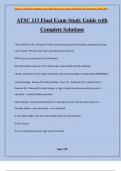EMILLECT 2024/2025 ACADEMIC YEAR ©2024 EMILLECT. ALL RIGHTS RESERVED FIRST PUBLISH OCTOBER, 2024
ATSC 113 Final Exam Study Guide with
Complete Solutions
VFR vs MVFR vs IFR - Answer✔✔-VFR: mostly by looking out the window, need good vis, stay
out of cloud. "VFR over top" when cloud below and clear air.
MVFR: poor vis, low cloud, but VFR allowed.
IFR: bad weather, stay out of TS, volcanic ash, supercooled cloud & raindrops.
Ceiling - Answer✔✔-alt of lowest cloud base with cloud coverage ≥ 5 oktas below 20000ft/6km
Cloud Coverage - Answer✔✔-Clear (0 oktas) - Few (1,2) - Scattered (3,4) - Broken (5,6,7) -
Overcast (8) - Obscured (9, indef ceiling, i.e. fog). If cloud cannot be seen from ground ->
obscured -> vertical visibility reported.
Static stability - Answer✔✔-Depends on T layering not wind. Cool air under warm air ->
statically stable -> w/o wind shear -> non-turbulent.
If S>0, stable (night, clear sky, calm winds), becomes non-turbulent.
If S=0, neutral.
If S<0, unstable (sunny days, light wind), turbulent.
Page 1/40
,EMILLECT 2024/2025 ACADEMIC YEAR ©2024 EMILLECT. ALL RIGHTS RESERVED FIRST PUBLISH OCTOBER, 2024
CAPE & K-Index - Answer✔✔-Convective Available Potential Energy measures accumulated
buoyant E of a rising warm humid air, proportional to storm violence.
K-Index measures T&dew-point(humidity) at few key alt, useful for rain-intensity.
Sounding - Answer✔✔-Measuring air T at dif. alt. Measured by rawinsondes.
Squall line - Answer✔✔-Line of TS not along a front, in warm air, can be triggered by wind shear
or may form from cold front and progress faster.
Cold & Warm Fronts - Answer✔✔-Cold air advances -> cold front.
Warm air advances -> warm front.
Dad Joke - Answer✔✔-Today, my son asked "Can I have a book mark?" and I burst into tears. 11
years old and he still doesn't know my name is Brian.
cold occlusion - Answer✔✔-Advancing cold front has colder air than the cold air ahead of warm
front and merge together.
Dry Line - Answer✔✔-A boundary btw dry & humid air at same T. Dry air denser, moist air rises
=> TS. Like a cold front.
Cold front - Answer✔✔-Southerly in NA, warm humid air advects from S. Strong winds, gusty, P
rel. Min.
Associated w/ Cumuliform clouds.
T decreases w/ time behind the front.
Page 2/40
,EMILLECT 2024/2025 ACADEMIC YEAR ©2024 EMILLECT. ALL RIGHTS RESERVED FIRST PUBLISH OCTOBER, 2024
Winds are stronger near fronts
Cold fronts bring a narrow band of precipitaiton
Warm front - Answer✔✔-Easterly ahead southerly behind, Wind ahead is cool & humid.
Associated w/ Stratiform clouds ahead. Alongside, extensive low clouds & fog.
Weak T gradient
Gradual T increase may change the precipitation
Reduced vis & thick clouds/fog
TS - Answer✔✔-Convective clouds driven by buoyancy of warm rising air. Most common in
spring & summer. Stay at least 20 nm away.
TS cells - Answer✔✔-*Each is an individual TS.
1) Cumulus: updraft, no rain, no anvil, not vis on radar.
2) mature: up & down drafts, rain, anvil, most violent, rain vis on radar.
3) Dissipating: Down, raining itself out, leaving ice crystals in the mid & top, not very vis on
radar.
*4) Residue: ice crystals in the anvil, long time to evap, blocks VFR.
Single-cell & Multi-cell storm TS - Answer✔✔-basic storms
Single-cell: short-lived (15-30min), not violent.
Multi-cell: 2 or more, each can be at dif. stages.
Page 3/40
, EMILLECT 2024/2025 ACADEMIC YEAR ©2024 EMILLECT. ALL RIGHTS RESERVED FIRST PUBLISH OCTOBER, 2024
Orographic TS - Answer✔✔-Formed when wind blows warm, humid air towards hills & Mt, if
cloud forms -> could develop into TS. If stationary, flashfloods. Basic Storm (along w/ single &
multi-cell).
Bow-echo TS - Answer✔✔-Line of TS bent into an arc by fast wind fromt behind (rear inflow jet).
Mesoscale Convective Complex - Answer✔✔-Line/region of strong TS cells w/ heavy rain
followed by moderate & light rain extending over a broad region. (Mesoscale convective system
TS including squall-line, bow-echo, mesoscale convective vortex).
Mesoscale convective vortex - Answer✔✔-After MCC dissipates, MCV is the remaining non-
stormy clouds at mid-alt w/ a slow cc-rotation. May lead to MCC from heat next day.
Super cell TS - Answer✔✔-most dangerous/ longest-lived, updraft often appear as slow rotating
cloud column => mesocyclone (supercell). Includes (low- & high-precipitation and classic
supercells.
Low- & high-precipitation supercell TS - Answer✔✔-Low: not much rain, may produce large hail
& downburst winds.
High: rain much more extensive, rain wrapped completely around the centre of rotation of
mesocyclone.
Classic supercell TS - Answer✔✔-Though only a small % supercells spawn tornadoes, they are
the strongest.
These can have a hook echo shape as rain wraps L pressure region of the storm called meso-low.
Page 4/40




